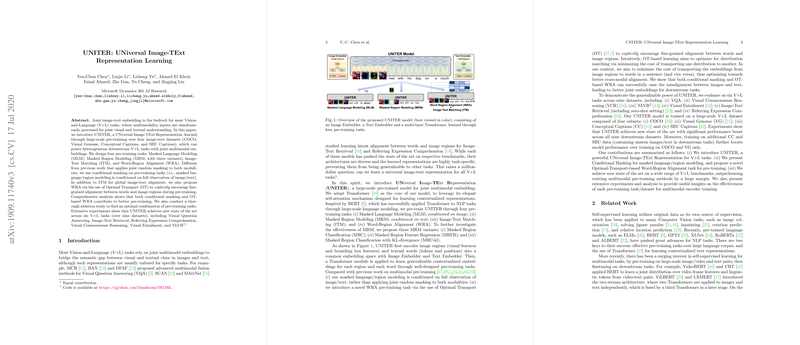UNITER: Universal Image-TExt Representation Learning
The UNITER model presents a significant advancement in the domain of Vision-and-Language (V+L) representation learning. This paper introduces an architecture designed to learn joint representations for both images and text through large-scale pre-training, utilizing datasets such as COCO, Visual Genome, Conceptual Captions, and SBU Captions. The model is evaluated across a variety of downstream V+L tasks, showcasing its versatility and robustness.
Model Architecture
UNITER leverages a Transformer-based architecture for its core model, employing the self-attention mechanism to learn contextualized embeddings. This approach allows for the effective integration of visual and textual information within a unified framework. The architecture consists of an Image Embedder and a Text Embedder, which process the image regions and textual tokens, respectively. These are followed by a multi-layer Transformer that learns cross-modal contextualized embeddings.
Pre-training Tasks
The authors propose four key pre-training tasks to nurture this joint multimodal representation:
- Masked LLMing (MLM): Conditional masking is applied, allowing the model to predict masked words based on surrounding text and full visual context.
- Masked Region Modeling (MRM): Three variants are used to predict masked visual regions: feature regression, classification, and KL-divergence-based classification.
- Image-Text Matching (ITM): This task involves predicting the alignment between image-text pairs.
- Word-Region Alignment (WRA): Utilizing Optimal Transport, this task ensures fine-grained alignment between textual tokens and image regions.
Results and Comparative Analysis
Empirically, UNITER achieves state-of-the-art performance across several benchmarks, including Visual Question Answering, Image-Text Retrieval, and Visual Entailment, among others. Notably, the inclusion of Optimal Transport-based WRA significantly enhances alignment capacities, yielding improvements particularly in tasks involving region-level recognition. Conditional masking further mitigates potential misalignments, enhancing learning efficiency and accuracy.
Theoretical and Practical Implications
The comprehensive analysis presented indicates that both conditional masking and OT-based WRA jointly contribute to robust pre-training. The novel approach to pre-training tasks ensures that the representations learned by UNITER are more generalizable across varied V+L tasks. This work extends further into the development of universal representations that can transcend task-specific constraints, signaling a step towards more efficient multimodal models.
Future Directions
Moving forward, the potential for early interactions between tokens and raw image pixels presents intriguing avenues for research, promising to refine the granularity of cross-modal embeddings.
Overall, UNITER offers a well-validated and theoretically sound approach to universal image-text representation learning, setting a new standard for future research in this domain.
